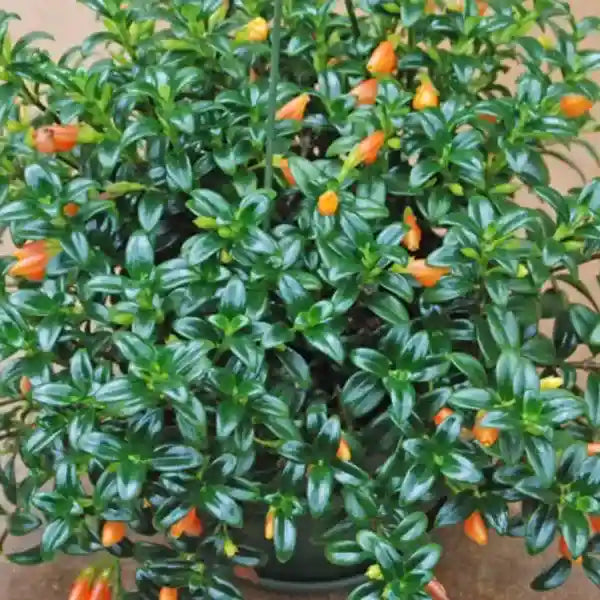
Goldfish Pant (Columnea Nematanthus )
Selling Size :Last Image | Pot Included | Secure Packing
The Nematanthus, commonly known as the Goldfish Plant, is a popular houseplant due to its unique, fish-shaped flowers and relatively easy care.
Here's a comprehensive guide care to Goldfish Plant :
1. Light:
Bright, indirect light is ideal. A spot near an east or north-facing window is perfect.
Avoid direct sunlight, especially during hot afternoon hours, as it can scorch the leaves.
Too little light can lead to leggy growth and prevent blooming. If natural light is limited, consider a grow light, especially in winter.
2. Soil:
Use a well-draining, peat-based potting mix.
A good mix might include ingredients like perlite or vermiculite to ensure adequate drainage and aeration.
Being epiphytic in nature, they prefer a coarser, lighter soil. African violet soil or a mix designed for tropical plants or orchids can also work well.
Ensure the pot has plenty of drainage holes to prevent root rot.
3. Watering:
Keep the soil consistently moist but not waterlogged.
Water when the top 1-2 inches of soil feel dry to the touch.
During the growing season (spring and summer), water generously.
Reduce watering in the fall and winter when the plant's growth slows, allowing the soil to dry out slightly between waterings, but never completely.
Use room-temperature water to avoid shocking the roots.
Avoid watering the leaves directly, as this can lead to fungal problems. Always empty any excess water from the saucer.
4. Humidity:
Goldfish Plants flourish in high-humidity environments.
If your home is dry, especially in winter, use a humidifier or place the plant on a humidity tray (a tray filled with pebbles and water, with the pot sitting on top of the pebbles, not in the water).
While some sources suggest misting, it's generally best to avoid misting the leaves directly to prevent fungal issues. Focus on increasing ambient humidity.
5. Temperature:
This plant thrives in warm conditions, ideally between 18∘C to 27∘C (65∘F to 80∘F).
It's sensitive to cold drafts and temperatures below 10∘C (50∘F), which can cause leaf drop and other stress-related issues. Keep it away from cold windows or air conditioners.
6. Fertilizing:
Feed your Goldfish Plant every two weeks during the growing season (spring and summer) with a balanced liquid fertilizer diluted to half strength.
Reduce feeding to once a month during the dormant period in the fall and winter, or stop altogether.
A phosphorus-rich fertilizer can encourage more blooms.
7. Pruning:
Regular pruning helps maintain a bushy and attractive shape and encourages more flowers.
After the plant finishes flowering, trim back the stems to encourage branching and new growth.
Trim leggy stems to promote bushiness and flower production.
8. Repotting:
Repot your Goldfish Plant every 1-2 years in spring using fresh, well-draining potting mix.
Choose a pot slightly larger than the current one with good drainage.
They don't mind being a little root-bound.
9. Propagation:
Goldfish Plants are easily propagated by stem cuttings.
Method 1: Soil Cuttings
Cut a 4-6 inch piece of stem that includes several leaves, ensuring there are no flowers or buds on the cutting.
Remove the lower leaves.
Dip the cut end in rooting hormone (optional, but helpful).
Plant it in moist, well-draining potting mix.
Keep the soil moist and covered with plastic (to create a humid environment) until the cutting roots, which typically takes a few weeks.
Method 2: Water Cuttings
Follow the same cutting procedure.
Place the cutting in a clean glass jar with room-temperature water, ensuring the node is submerged and leaves are above the waterline.
Change the water every few days to keep it fresh.
Roots should develop within 2-4 weeks. Once roots are 3-5 inches long, transplant to soil.
Common Problems and Solutions:
Root Rot: Caused by overwatering or poor drainage. Symptoms include wilting, yellowing leaves, and general decline. Ensure good drainage and allow soil to dry slightly between waterings.
Powdery Mildew: Appears as a white, powdery coating on leaves, often due to high humidity and poor air circulation. Improve air circulation.
Leaf Drop: Sudden temperature changes, drafts, or incorrect watering can cause leaves to drop. Maintain a consistent environment.
Leaf Scorch: Direct sunlight can burn the leaves. Move to a brighter, indirect light spot.
No Blooms: Insufficient light or nutrients are common causes. Provide plenty of indirect light and maintain a consistent fertilizing schedule during the growing season.
Wilting: Can be due to both overwatering and underwatering. Check soil moisture to determine the cause and adjust watering.
Leggy Growth: Often caused by too little light or sometimes overwatering/high humidity. Increase light exposure and prune to encourage bushiness.
By following these care tips, your Nematanthus (Goldfish Plant) should provide you with its charming, fish-like blooms for years to come!

